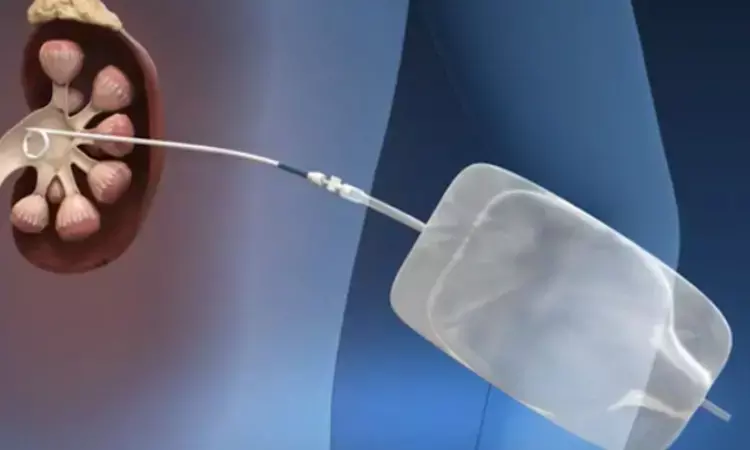- Home
- Medical news & Guidelines
- Anesthesiology
- Cardiology and CTVS
- Critical Care
- Dentistry
- Dermatology
- Diabetes and Endocrinology
- ENT
- Gastroenterology
- Medicine
- Nephrology
- Neurology
- Obstretics-Gynaecology
- Oncology
- Ophthalmology
- Orthopaedics
- Pediatrics-Neonatology
- Psychiatry
- Pulmonology
- Radiology
- Surgery
- Urology
- Laboratory Medicine
- Diet
- Nursing
- Paramedical
- Physiotherapy
- Health news
- Fact Check
- Bone Health Fact Check
- Brain Health Fact Check
- Cancer Related Fact Check
- Child Care Fact Check
- Dental and oral health fact check
- Diabetes and metabolic health fact check
- Diet and Nutrition Fact Check
- Eye and ENT Care Fact Check
- Fitness fact check
- Gut health fact check
- Heart health fact check
- Kidney health fact check
- Medical education fact check
- Men's health fact check
- Respiratory fact check
- Skin and hair care fact check
- Vaccine and Immunization fact check
- Women's health fact check
- AYUSH
- State News
- Andaman and Nicobar Islands
- Andhra Pradesh
- Arunachal Pradesh
- Assam
- Bihar
- Chandigarh
- Chattisgarh
- Dadra and Nagar Haveli
- Daman and Diu
- Delhi
- Goa
- Gujarat
- Haryana
- Himachal Pradesh
- Jammu & Kashmir
- Jharkhand
- Karnataka
- Kerala
- Ladakh
- Lakshadweep
- Madhya Pradesh
- Maharashtra
- Manipur
- Meghalaya
- Mizoram
- Nagaland
- Odisha
- Puducherry
- Punjab
- Rajasthan
- Sikkim
- Tamil Nadu
- Telangana
- Tripura
- Uttar Pradesh
- Uttrakhand
- West Bengal
- Medical Education
- Industry
Flank Position Safe and Effective for Kidney Stone Removal Surgery among obese and high risk patients: Study

A recent comprehensive meta-analysis focused on the safety and efficacy of the flank position during percutaneous nephrolithotomy (PCNL) for the removal of kidney stones and suggests that this surgical position may offer distinct advantages for certain high-risk patient groups.
The study systematically reviewed data from multiple databases including PubMed, Embase, SCOPUS, the Cochrane database libraries and the Chinese Biomedical Literature Database. This research included 7 randomized controlled trials which encompassed a total of 587 patients. By employing rigorous inclusion criteria and analytical methods using RevMan 5.4 software, the team led by Changjian Zheng aimed to provide a clear comparative analysis between the flank and the more traditional prone positions used during PCNL.
The key findings from the study revealed a statistically significant lower reduction in hemoglobin levels in the patients who were operated in the flank position when compared to the individuals in the prone position. The mean difference in hemoglobin reduction was −0.15 with a 95% confidence interval from −0.22 to −0.08 that indicates lesser blood loss during the surgery which is a crucial factor for patient safety.
Also, the analysis showed no significant differences in several other critical outcomes such as the stone-free rate, operative time, length of hospital stay and postoperative complications categorized under Clavien grades I, II and III. These results suggest that the flank position does not compromise the effectiveness or the safety of the surgery when compared to the prone position.
The flank position that involves the patient lying on their side was considered particularly advantageous for obese patients or the individuals with reduced cardiopulmonary function, as this can potentially reduce the stress on the heart and lungs during the operation.
Despite these positive results, the study advocate for more extensive trials to further validate their findings. While the results are encouraging, confirming these benefits across a broader demographic and with larger sample sizes is crucial for universal recommendation.
The findings have significant benefits on clinical practice in the treatment of nephrolithiasis, which affects millions worldwide and often requires surgical intervention. The flank position could become a preferred method in PCNL procedures by potentially offering a safer alternative for high-risk patients. This also helps in ensuring better patient outcomes and potentially reduces the risks associated with this common surgery.
Reference:
Zheng, C., Yang, H., Lv, Y., & Yang, L. (2024). Flank versus prone position in percutaneous nephrolithotomy: a meta-analysis of randomized controlled studies. In Urolithiasis (Vol. 52, Issue 1). Springer Science and Business Media LLC. https://doi.org/10.1007/s00240-024-01557-4
Neuroscience Masters graduate
Jacinthlyn Sylvia, a Neuroscience Master's graduate from Chennai has worked extensively in deciphering the neurobiology of cognition and motor control in aging. She also has spread-out exposure to Neurosurgery from her Bachelor’s. She is currently involved in active Neuro-Oncology research. She is an upcoming neuroscientist with a fiery passion for writing. Her news cover at Medical Dialogues feature recent discoveries and updates from the healthcare and biomedical research fields. She can be reached at editorial@medicaldialogues.in
Dr Kamal Kant Kohli-MBBS, DTCD- a chest specialist with more than 30 years of practice and a flair for writing clinical articles, Dr Kamal Kant Kohli joined Medical Dialogues as a Chief Editor of Medical News. Besides writing articles, as an editor, he proofreads and verifies all the medical content published on Medical Dialogues including those coming from journals, studies,medical conferences,guidelines etc. Email: drkohli@medicaldialogues.in. Contact no. 011-43720751


